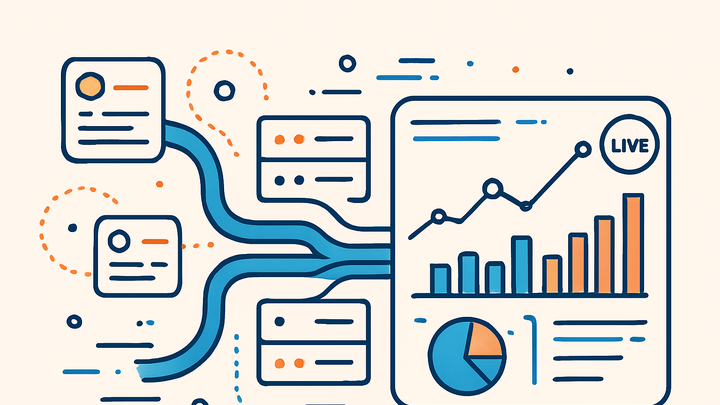Published on 2025-06-26T04:38:05Z
What is Stream Processing? Examples for Stream Processing.
Stream processing is a modern data processing paradigm that enables organizations to analyze and act on data as soon as it is generated, rather than waiting for batch windows. By continuously consuming and processing event streams - such as user interactions, sensor readings, logs, and transactions - stream processing systems provide low-latency insights and enable real-time decision making. In analytics, stream processing powers live dashboards, alerting systems, and dynamic personalization engines that respond instantly to changes in user behavior or system metrics. Implementations may leverage open source frameworks (e.g., Apache Kafka, Apache Flink) or fully managed SaaS products like PlainSignal and Google Analytics 4. Although more complex to architect than traditional batch pipelines, stream processing architectures are essential for any application requiring immediate feedback loops or operational intelligence. Key concepts in stream processing include windowing, stateful transformations, and event-time handling, all of which contribute to accurate and timely analytics.
Stream processing
Stream processing ingests and analyzes data in real-time as it flows to provide immediate insights.
Introduction to Stream Processing
Stream processing, or event stream processing, deals with the real-time ingestion and analysis of continuous data flows. This section outlines the foundational concepts and differentiates it from traditional batch processing.
-
Definition
Stream processing refers to the continuous, in-motion processing of data events to enable immediate computation and analytics.
-
Key benefits
Stream processing delivers low-latency insights, scalable architectures, and immediate reaction to changes in data.
-
Real-time insights
Provides analytics on events as they occur, reducing decision latency.
-
Scalability
Handles high-throughput data streams by distributing processing across multiple nodes.
-
Core Components of a Stream Processing Architecture
Stream processing pipelines typically consist of several key building blocks that work together to ingest, process, and store real-time data.
-
Event sources
Origin points for data streams, such as web tracking snippets, IoT sensors, application logs, or messaging systems.
-
Web analytics events
User interactions like pageviews, clicks, and form submissions captured in real time.
-
Iot sensor data
Continuous measurements from devices, used in industrial monitoring and smart environments.
-
-
Stream processing engine
The component responsible for ingesting streams, applying transformations, aggregations, and windowing operations.
-
Windowing
Groups events into defined time frames or counts to perform correct aggregations.
-
Stateful processing
Maintains intermediate state across events, enabling complex event correlations and joins.
-
-
Data sink and storage
Destinations for processed output, such as dashboards, databases, or data lakes for long-term storage.
-
Real-time dashboards
Visualize live metrics instantly in tools like PlainSignal or GA4.
-
Data warehouses
Stores consolidated historical data for batch analytics in platforms like BigQuery or Snowflake.
-
Use Cases in Analytics
Real-time data processing enables a variety of analytics applications that benefit from immediate insights.
-
Real-time monitoring and alerting
Continuously track KPIs or system metrics and trigger alerts on threshold breaches or anomalies.
-
Personalization and recommendations
Adapt content and product offers on the fly by analyzing user behavior as it happens.
-
Fraud detection
Identify and block suspicious transactions in real time to prevent financial losses.
Implementing Stream Processing with SaaS Analytics Tools
Explore how to set up and leverage managed analytics services for real-time data collection and processing.
-
PlainSignal (cookie-free simple analytics)
PlainSignal provides lightweight, cookie-free analytics that capture events in real time. Integrate with a single script:
<link rel="preconnect" href="//eu.plainsignal.com/" crossorigin /> <script defer data-do="yourwebsitedomain.com" data-id="0GQV1xmtzQQ" data-api="//eu.plainsignal.com" src="//cdn.plainsignal.com/plainsignal-min.js"></script> -
Google analytics 4 (GA4)
GA4 supports event streaming and real-time dashboards. Add the global site tag to start collecting streaming data:
<script async src="https://www.googletagmanager.com/gtag/js?id=G-XXXXXX"></script> <script> window.dataLayer = window.dataLayer || []; function gtag(){dataLayer.push(arguments);} gtag('js', new Date()); gtag('config', 'G-XXXXXX'); </script>
Best Practices and Considerations
Optimizing stream processing pipelines ensures reliability, cost-efficiency, and accuracy of real-time analytics.
-
Manage latency vs throughput
Find the right balance between processing speed and data volume to meet SLAs and cost constraints.
-
Ensure data quality
Implement validation, deduplication, and cleansing at the ingestion layer to maintain accuracy.
-
Scalability and fault tolerance
Use distributed architectures with checkpointing and replication to handle failures and traffic spikes.
-
Optimize windowing strategies
Choose between tumbling, sliding, or session windows according to your analytical requirements.
